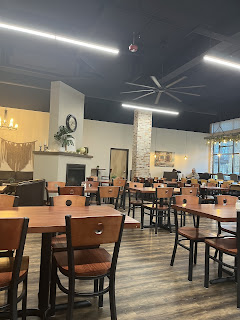Encounter & Gabrieli
Are you even a music student at the University of Iowa if you don't regularly go to the Encounter Cafe? Its location and cinnamon rolls can't be beat. I go here more than my bank account would probably like, but it's more than worth it. I'm sure that everyone reading this blog has already been here many times, so I won't bother with a review of a place we all know & love.
Maybe this post will be the tipping point so we can finally have class at the Annex.... 👀
I figured it would be best to pair a Voxman staple with a brass ensemble classic: music by Giovanni Gabrieli. Gabrieli was one of the leading composers of the Italian Renaissance. His output features both vocal and instrumental works written for the church. His works for multiple antiphonal choirs are some of the earliest works we have today for brass ensemble. They have been transcribed for modern instruments by multiple people and with slightly varying performing forces. Gabrieli works are great for student ensembles because they teach students about playing in a completely different style and independence, as his works are much more polyphonic than much of the music we play in school ensembles (which can be very homophonic for brass instruments). It is also beneficial for students to perform the music from the various periods they learn about in their music history curriculum.
For today's purposes, I chose to focus on Gabrieli's Sonata XIII. It features two choirs playing with prescribed dynamics, similar to Gabrieli's best known Sonata pian' e forte. The two ensembles perform similar motifs in conversation with one another.
Here is a recording of the work performed by the Empire Brass from their CD Music of Gabrieli. Empire Brass is a quintet founded in 1971 after the founding members met at the Tanglewood Music Center. This album was released in 1989 and features a variety of Gabrieli compositions. This particular recording takes faster tempos than some other modern transcriptions I’ve found for this piece, which provides for a more dynamic interpretation. Because of this, it is easier to feel the middle portion of the work in 1, whereas recordings with slower tempi can sometimes fluctuate between feeling in 3 and 1. The trumpets also add additional ornamentation on some passages, which feels in the correct style of the piece.




What are your opinions on the adaptation of Gabrieli's music to brass instrumentation? Would you prefer to hear his music in a historic ensemble, modern brass quintet, or a large ensemble e.g. a 72-person hornline?
ReplyDelete